start Lexus IS250C 2010 Owner's Guide
[x] Cancel search | Manufacturer: LEXUS, Model Year: 2010, Model line: IS250C, Model: Lexus IS250C 2010Pages: 586, PDF Size: 31.62 MB
Page 90 of 586

89
1-4. Opening and closing the windows and retractable hardtop
1
Before driving
10_IS250C/350C_U
NOTICE
■Precautions for opening/closing the retractable hardtop
●Before operating the retractable hardtop, make sure that the areas 2.3 ft. (70
cm) above the roof and 1.2 ft. (35 cm) behind the rear bumper is clear of obstruc-
tions.
●Do not put any items or packages on the package tray even if they are extremely
small.
●Do not store luggage on or allow anyone to sit on the retractable hardtop.
●When the outside temperature is -4°F (-20°C) or below or if the side windows
are frozen shut, do not open or close the retractable hardtop.
●When opening or closing the retractable hardtop, turn the rear window defog-
gers off.
●Do not leave the vehicle for an extended period of time with an open or close
operation incomplete.
●Do not open the trunk lid while the retractable hardtop is operating.
●If the retractable hardtop is operated repeatedly within a short period of time, the
motor protection circuit may activate, causing the roof switch to be disabled. In
this case, turn the “ENGINE START STOP” switch to ACCESSORY mode or off
and, after waiting for a while, perform the procedure again.
●Do not place anything on or under the luggage cover.
●The luggage cover should be attached securely. Protruding luggage may inter-
fere with the proper operation of the retractable hardtop.
■To prevent battery discharge
Do not operate the retractable hardtop repeatedly when the engine is off.
Page 91 of 586
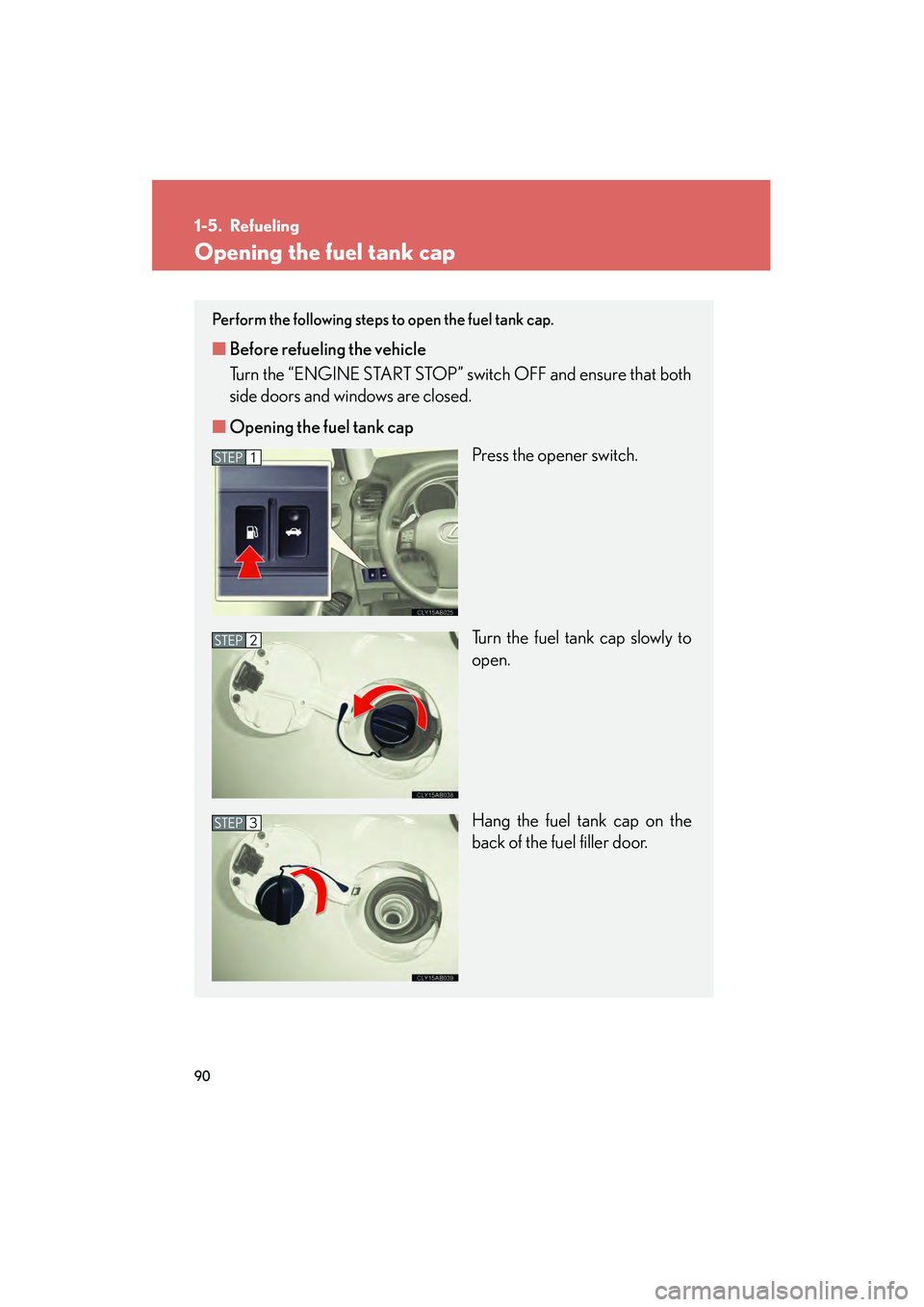
90
10_IS250C/350C_U
1-5. Refueling
Opening the fuel tank cap
Perform the following steps to open the fuel tank cap.
■Before refueling the vehicle
Turn the “ENGINE START STOP” switch OFF and ensure that both
side doors and windows are closed.
■ Opening the fuel tank cap
Press the opener switch.
Turn the fuel tank cap slowly to
open.
Hang the fuel tank cap on the
back of the fuel filler door.
STEP1
STEP2
STEP3
Page 94 of 586

93
1
Before driving
10_IS250C/350C_U
1-6. Theft deterrent system
Engine immobilizer system
■System maintenance
The vehicle has a maintenance-free type of engine immobilizer system.
■Conditions that may cause the system to malfunction
●If the grip portion of the key is in contact with a metallic object
●If the key is in close proximity to or touching a key to the security system (key
with a built-in transponder chip) of another vehicle
The vehicle's keys have built-in transponder chips that prevent the engine
from starting if the key has not been previously registered in the vehicle's
on-board computer.
Never leave the keys inside the vehicle when you leave the vehicle.
The indicator light flashes after
the “ENGINE START STOP”
switch has been turned OFF to
indicate that the system is oper-
ating.
Page 96 of 586
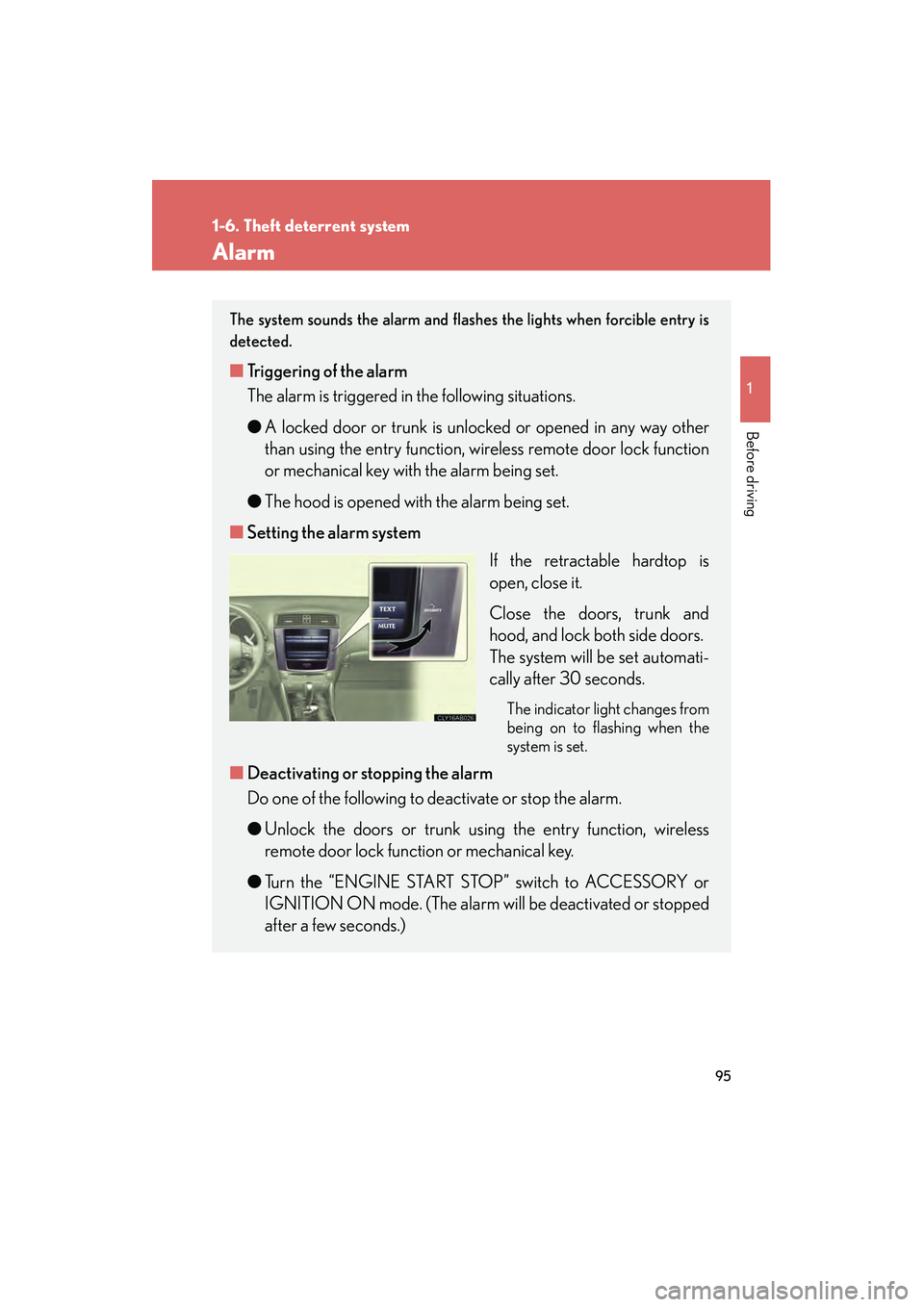
95
1
1-6. Theft deterrent system
Before driving
10_IS250C/350C_U
Alarm
The system sounds the alarm and flashes the lights when forcible entry is
detected.
■Triggering of the alarm
The alarm is triggered in the following situations.
●A locked door or trunk is unlocked or opened in any way other
than using the entry function, wireless remote door lock function
or mechanical key with the alarm being set.
● The hood is opened with the alarm being set.
■ Setting the alarm system
If the retractable hardtop is
open, close it.
Close the doors, trunk and
hood, and lock both side doors.
The system will be set automati-
cally after 30 seconds.
The indicator light changes from
being on to flashing when the
system is set.
■Deactivating or stopping the alarm
Do one of the following to deactivate or stop the alarm.
●Unlock the doors or trunk using the entry function, wireless
remote door lock functi on or mechanical key.
● Turn the “ENGINE START STOP” switch to ACCESSORY or
IGNITION ON mode. (The alarm will be deactivated or stopped
after a few seconds.)
Page 132 of 586
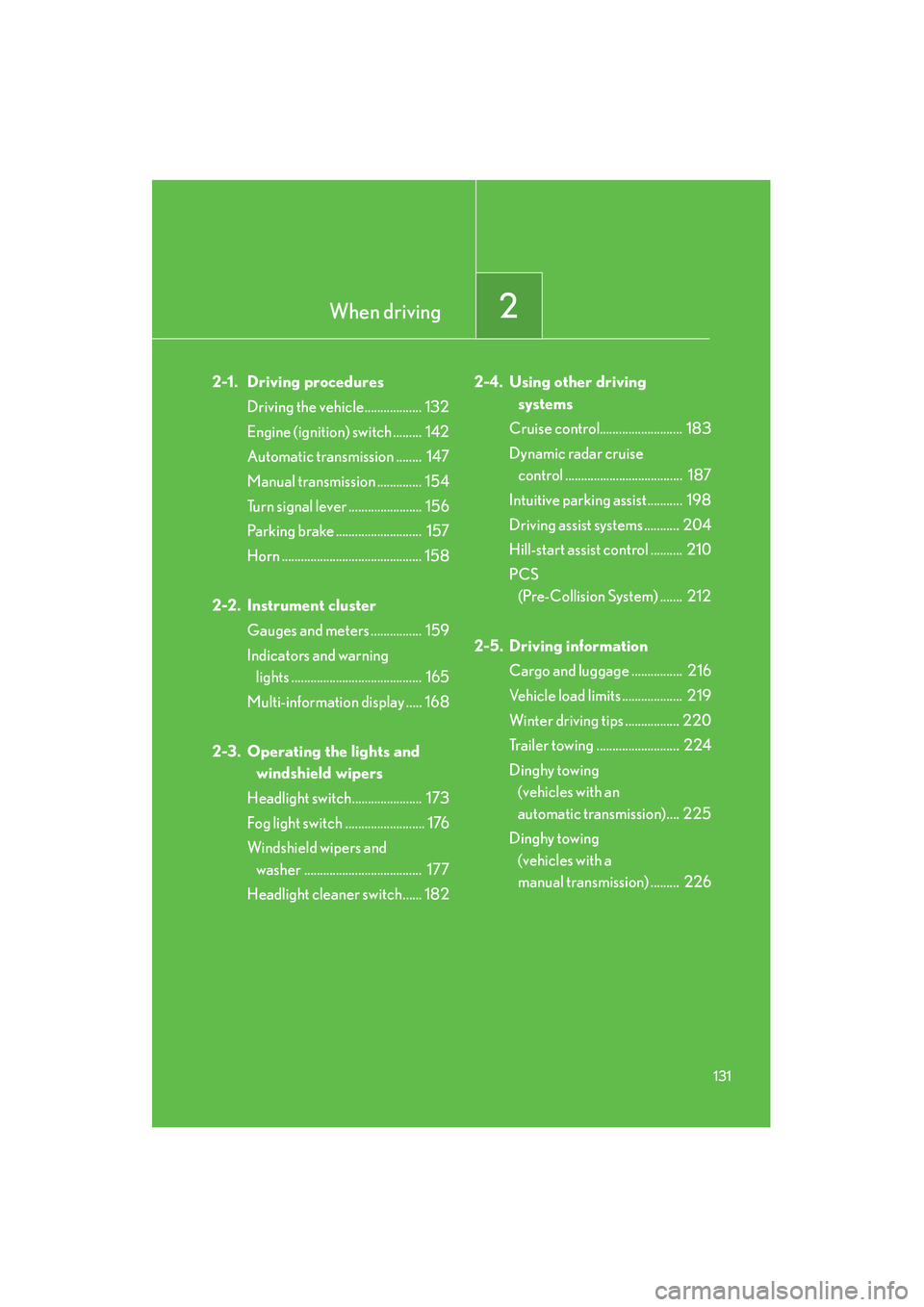
When driving2
131
10_IS250C/350C_U
2-1. Driving proceduresDriving the vehicle.................. 132
Engine (ignition) switch ......... 142
Automatic transmission ........ 147
Manual transmission .............. 154
Turn signal lever ....................... 156
Parking brake ........................... 157
Horn ............................................ 158
2-2. Instrument cluster Gauges and meters ................ 159
Indicators and warning lights ......................................... 165
Multi-information display ..... 168
2-3. Operating the lights and windshield wipers
Headlight switch...................... 173
Fog light switch ......................... 176
Windshield wipers and washer ..................................... 177
Headlight cleaner switch...... 182 2-4. Using other driving
systems
Cruise control.......................... 183
Dynamic radar cruise control ..................................... 187
Intuitive parking assist ........... 198
Driving assist systems ........... 204
Hill-start assist control .......... 210
PCS (Pre-Collision System) ....... 212
2-5. Driving information Cargo and luggage ................ 216
Vehicle load limits ................... 219
Winter driving tips ................. 220
Trailer towing .......................... 224
Dinghy towing (vehicles with an
automatic transmission).... 225
Dinghy towing (vehicles with a
manual transmission) ......... 226
Page 133 of 586
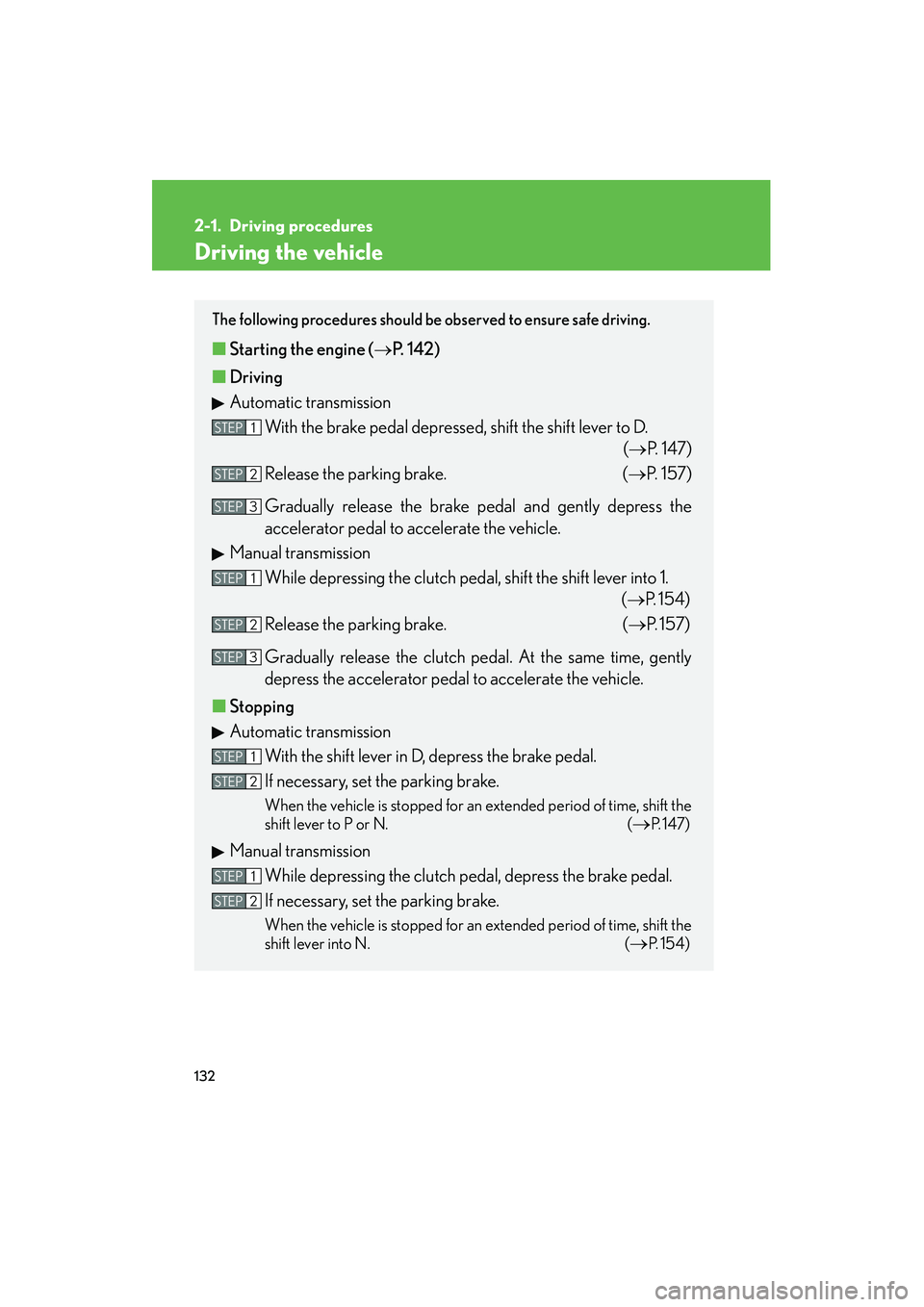
132
10_IS250C/350C_U
2-1. Driving procedures
Driving the vehicle
The following procedures should be observed to ensure safe driving.
■Starting the engine ( →P. 142)
■ Driving
Automatic transmission
With the brake pedal depressed, shift the shift lever to D. (→P. 147)
Release the parking brake. (→ P. 1 5 7 )
Gradually release the brake pedal and gently depress the
accelerator pedal to accelerate the vehicle.
Manual transmission
While depressing the clutch pedal, shift the shift lever into 1. (→P. 1 5 4 )
Release the parking brake. (→ P. 1 5 7 )
Gradually release the clutch pedal. At the same time, gently
depress the accelerator pedal to accelerate the vehicle.
■ Stopping
Automatic transmission
With the shift lever in D, depress the brake pedal.
If necessary, set the parking brake.
When the vehicle is stopped for an extended period of time, shift the
shift lever to P or N. (
→P. 1 4 7 )
Manual transmission
While depressing the clutch pedal, depress the brake pedal.
If necessary, set the parking brake.
When the vehicle is stopped for an extended period of time, shift the
shift lever into N. (
→P. 1 5 4 )
STEP1
STEP2
STEP3
STEP1
STEP2
STEP3
STEP1
STEP2
STEP1
STEP2
Page 134 of 586
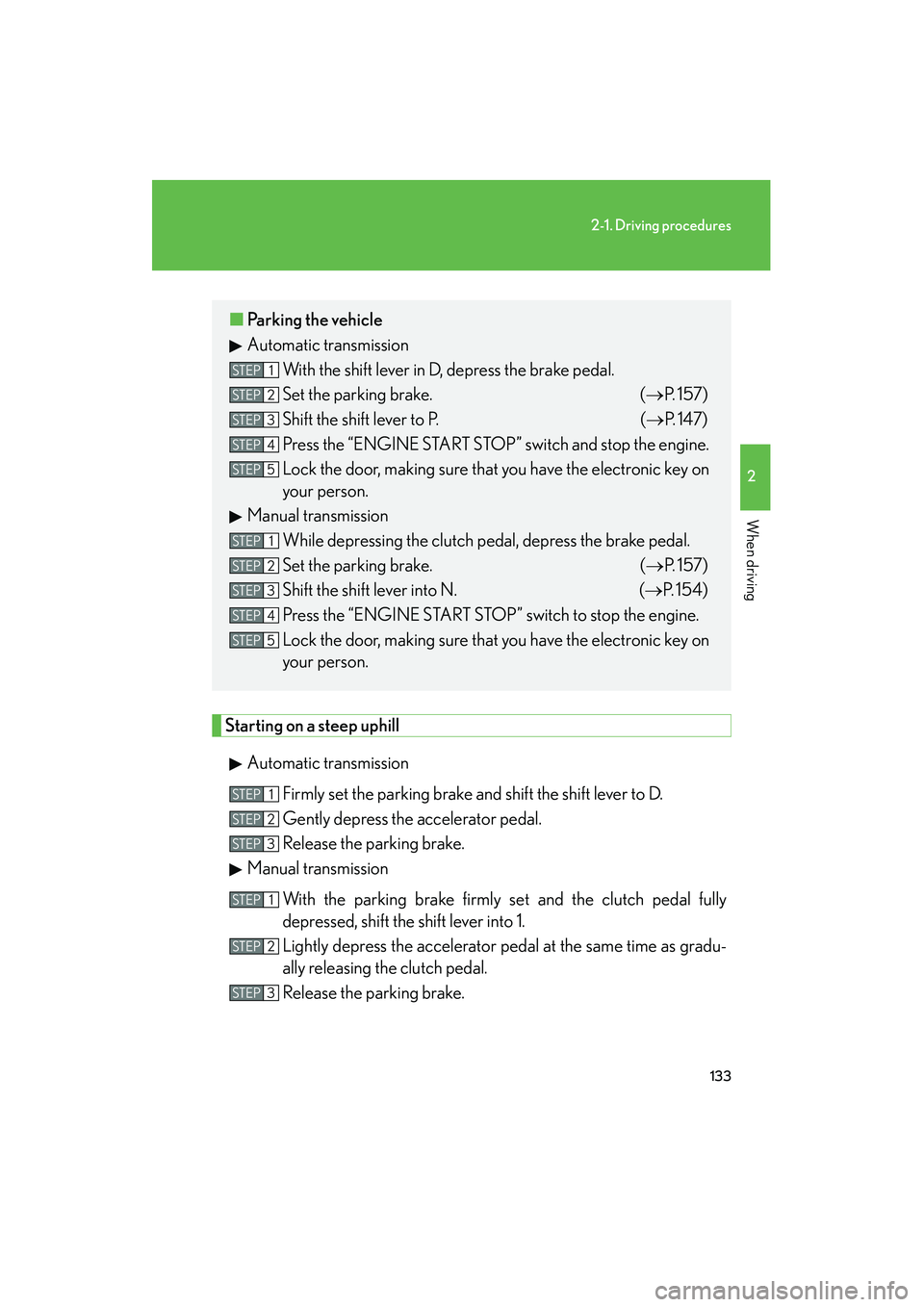
133
2-1. Driving procedures
2
When driving
10_IS250C/350C_U
Starting on a steep uphillAutomatic transmission Firmly set the parking brake and shift the shift lever to D.
Gently depress the accelerator pedal.
Release the parking brake.
Manual transmission
With the parking brake firmly set and the clutch pedal fully
depressed, shift the shift lever into 1.
Lightly depress the accelerator pedal at the same time as gradu-
ally releasing the clutch pedal.
Release the parking brake.
■Parking the vehicle
Automatic transmission
With the shift lever in D, depress the brake pedal.
Set the parking brake. (→P. 1 5 7 )
Shift the shift lever to P. (→ P. 147)
Press the “ENGINE START STOP” switch and stop the engine.
Lock the door, making sure that you have the electronic key on
your person.
Manual transmission
While depressing the clutch pedal, depress the brake pedal.
Set the parking brake. (→P. 1 5 7 )
Shift the shift lever into N. (→ P. 1 5 4 )
Press the “ENGINE START STOP” switch to stop the engine.
Lock the door, making sure that you have the electronic key on
your person.
STEP1
STEP2
STEP3
STEP4
STEP5
STEP1
STEP2
STEP3
STEP4
STEP5
STEP1
STEP2
STEP3
STEP1
STEP2
STEP3
Page 135 of 586

134
2-1. Driving procedures
10_IS250C/350C_U
■Starting off on a hill
Hill-start assist control will operate. (→P. 2 0 4 )
■Driving in the rain
●Drive carefully when it is raining, because visibility will be reduced, the windows
may become fogged-up, and the road will be slippery.
●Drive carefully when it starts to rain, because the road surface will be especially
slippery.
●Refrain from high speeds when driving on an expressway in the rain, because
there may be a layer of water between the tires and the road surface, preventing
the steering and brakes from operating properly.
■Breaking in your new Lexus
To extend the life of the vehicle, the following precautions are recommended to
observe:
●For the first 186 miles (300 km):
Avoid sudden stops.
●For the first 621 miles (1000 km):
• Do not drive at extremely high speeds.
• Avoid sudden acceleration.
• Do not drive continuously in the low gears.
• Do not drive at a constant speed for extended periods.
■Drum-in-disc type parking brake system
Your vehicle has a drum-in-disc type parking brake system. This type of brake sys-
tem needs bedding-down of the brake shoes periodically or whenever the parking
brake shoes and/or drum are replaced. Have your Lexus dealer perform the bed-
ding down.
■Operating your vehicle in a foreign country
Comply with the relevant vehicle registration laws and confirm the availability of the
correct fuel. ( →P. 529)
Page 136 of 586

135
2-1. Driving procedures
2
When driving
10_IS250C/350C_U
CAUTION
■When starting the vehicle
With automatic transmission vehicles, always keep your foot on the brake pedal
while stopped with the engine running. This prevents the vehicle from creeping.
■When driving the vehicle
●Do not drive if you are unfamiliar with the location of the brake and accelerator
pedals to avoid depressing the wrong pedal.
• Accidentally depressing the accelerator pedal instead of the brake pedal willresult in sudden acceleration that may lead to an accident that could result in
death or serious injury.
• When backing up, you may twist your body around, leading to a difficulty in operating the pedals. Make sure to operate the pedals properly.
• Make sure to keep a correct driving posture even when moving the vehicle only slightly, allowing you to depress the brake and accelerator pedals prop-
erly.
• Depress the brake pedal using your right foot. Depressing the brake pedal using your left foot may delay response in an emergency, resulting in an acci-
dent.
●Do not drive the vehicle over or stop the vehicle near flammable materials.
●With automatic transmission vehicles, do not let the vehicle roll backwards while
the shift lever is in a driving position, or roll forward while the shift lever is in R.
Doing so may cause the engine to stall or lead to poor brake and steering perfor-
mance, resulting in an accident or damage to the vehicle.
●If the smell of exhaust is noticed inside the vehicle, open the windows and check
that the trunk is closed. Large amounts of exhaust in the vehicle can cause driver
drowsiness and an accident, resulting in death or a serious health hazard. Have
the vehicle inspected by your Lexus dealer immediately.
●Do not under any circumstances shift the shift lever to P, R or N (vehicles with an
automatic transmission) or R (vehicles with a manual transmission) while the vehi-
cle is moving.
Doing so can cause significant damage to the transmission system and may result
in a loss of vehicle control.
●Do not shift the shift lever to N while the vehicle is moving.
Doing so may cause the engine brake to not operate properly and lead to an
accident.
Page 141 of 586

140
2-1. Driving procedures
10_IS250C/350C_U
NOTICE
■When driving the vehicleWith automatic transmission vehicles
●Do not use the accelerator pedal or depress the accelerator and brake pedals
together to hold the vehicle on a hill.With manual transmission vehicles
●Do not rest your foot on the clutch pedal while driving.
Doing so may cause clutch trouble.
●Do not use any gears other than the first gear when starting off and moving for-
ward.
Doing so may damage the clutch.
●Do not use the clutch to hold the vehicle when stopping on an uphill grade.
Doing so may damage the clutch.
■When parking the vehicle
With automatic transmission vehicles, always put the shift lever in P. Failure to do so
may cause the vehicle to move or the vehicle may accelerate suddenly if the accel-
erator pedal is accidentally depressed.
■Avoiding damage to vehicle parts
●Do not turn the steering wheel fully in either direction and hold it there for a long
time.
Doing so may damage the power steering motor.
●When driving over bumps in the road, drive as slowly as possible to avoid damag-
ing the wheels, underside of the vehicle, etc.